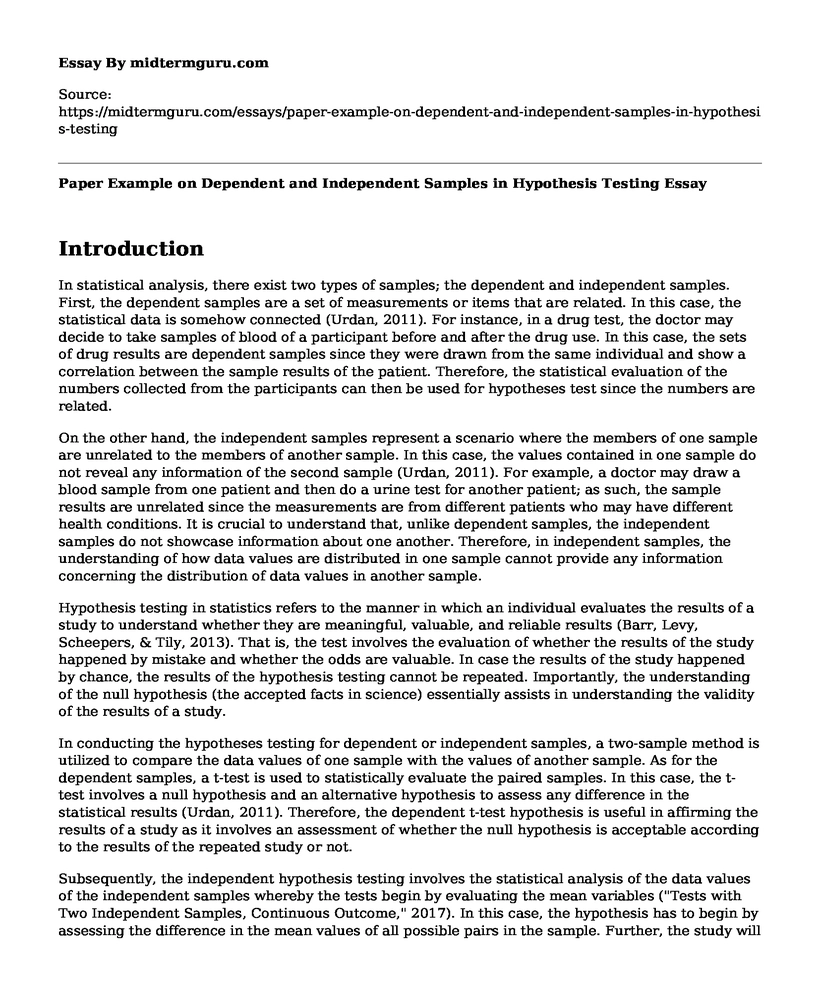Introduction
In statistical analysis, there exist two types of samples; the dependent and independent samples. First, the dependent samples are a set of measurements or items that are related. In this case, the statistical data is somehow connected (Urdan, 2011). For instance, in a drug test, the doctor may decide to take samples of blood of a participant before and after the drug use. In this case, the sets of drug results are dependent samples since they were drawn from the same individual and show a correlation between the sample results of the patient. Therefore, the statistical evaluation of the numbers collected from the participants can then be used for hypotheses test since the numbers are related.
On the other hand, the independent samples represent a scenario where the members of one sample are unrelated to the members of another sample. In this case, the values contained in one sample do not reveal any information of the second sample (Urdan, 2011). For example, a doctor may draw a blood sample from one patient and then do a urine test for another patient; as such, the sample results are unrelated since the measurements are from different patients who may have different health conditions. It is crucial to understand that, unlike dependent samples, the independent samples do not showcase information about one another. Therefore, in independent samples, the understanding of how data values are distributed in one sample cannot provide any information concerning the distribution of data values in another sample.
Hypothesis testing in statistics refers to the manner in which an individual evaluates the results of a study to understand whether they are meaningful, valuable, and reliable results (Barr, Levy, Scheepers, & Tily, 2013). That is, the test involves the evaluation of whether the results of the study happened by mistake and whether the odds are valuable. In case the results of the study happened by chance, the results of the hypothesis testing cannot be repeated. Importantly, the understanding of the null hypothesis (the accepted facts in science) essentially assists in understanding the validity of the results of a study.
In conducting the hypotheses testing for dependent or independent samples, a two-sample method is utilized to compare the data values of one sample with the values of another sample. As for the dependent samples, a t-test is used to statistically evaluate the paired samples. In this case, the t-test involves a null hypothesis and an alternative hypothesis to assess any difference in the statistical results (Urdan, 2011). Therefore, the dependent t-test hypothesis is useful in affirming the results of a study as it involves an assessment of whether the null hypothesis is acceptable according to the results of the repeated study or not.
Subsequently, the independent hypothesis testing involves the statistical analysis of the data values of the independent samples whereby the tests begin by evaluating the mean variables ("Tests with Two Independent Samples, Continuous Outcome," 2017). In this case, the hypothesis has to begin by assessing the difference in the mean values of all possible pairs in the sample. Further, the study will evaluate the difference between the mean values. Henceforth, the hypothesis testing may involve the sampling of the distribution between means and further converting the mean differences into z-scores. After the assessment of the z-scores, the statistical analysis can then involve the assessment of the pooled variance.
References
Barr, D. J., Levy, R., Scheepers, C., & Tily, H. J. (2013). Random effects structure for
confirmatory hypothesis testing: Keep it maximal. Journal of memory and language, 68(3), 255-278.
Tests with Two Independent Samples, Continuous Outcome. (2017). Retrieved from http://sphweb.bumc.bu.edu/otlt/MPH-Modules/BS/BS704_HypothesisTest-Means-Proportions/BS704_HypothesisTest-Means-Proportions6.html
Urdan, T. C. (2011). Statistics in plain English. Routledge.
Cite this page
Paper Example on Dependent and Independent Samples in Hypothesis Testing. (2022, Sep 13). Retrieved from https://midtermguru.com/essays/paper-example-on-dependent-and-independent-samples-in-hypothesis-testing
If you are the original author of this essay and no longer wish to have it published on the midtermguru.com website, please click below to request its removal:
- The Campaign Program: Volunteer to Advance the Quality of Education
- The Reliability of the Questionnaires: Teacher Confidence With ICT Survey and Satisfaction Scales
- Statistics Paper Example: Sampling Distribution
- Qualitative Research on Reflective Practice in Nursing Critique
- Workplace Incivility: A Growing Challenge in Our Organization - Essay Sample
- Under Armour's Strategy in 2014 - Case Study
- Exploring Theoretical and Best Practice Models in Research - Essay Sample







